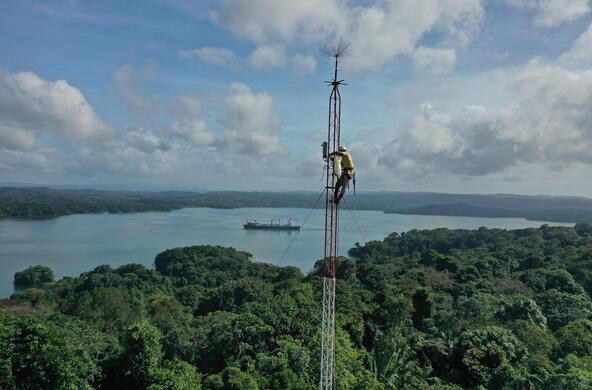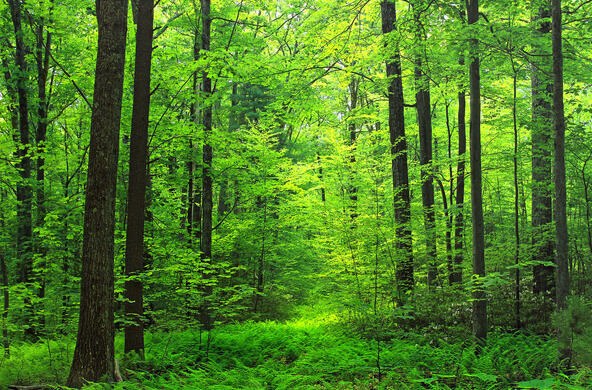Though no one may be around to hear when a tree falls in the forest, countless critters take note. Dormant fungi within the tree awaken to feast on it, joined by others that creep up from the soil. Bacteria pitch in, some sliding along strands of fungi to get deeper into the log. Termites alert their colony mates, which gather en masse to gobble up wood. Bit by bit, deadwood is decomposed, feeding new life along the way.
Yet breaking down wood — one of the toughest organic materials — is easier said than done, and scientists still have much to learn about the vital ecological process. Some are studying the tricks fungi and other microbes use to digest wood, and the ways that animals harness this skill for their own benefit. Others are tallying deadwood’s roles in recycling organic matter and stabilizing the global climate. What they’re learning is beginning to lay bare the complex interactions playing out inside expired trees.
“Just because it’s dead doesn’t mean it still doesn’t have a huge function in the ecosystem,” says ecologist Amy Zanne of the Cary Institute of Ecosystem Studies in New York state. Yet the amount of deadwood has been declining in many woodlands around the world, and with it, the vital life-giving role it plays.
When trees inhale carbon, some of it is used to build complex structural molecules like cellulose, hemicellulose and lignin. Cellulose — durable, tightly packed strands of the simple sugar glucose — form the wood’s framework, enclosed by wiry strings of hemicellulose. Concrete-like lignin, the toughest of the three, holds everything together.
Cellulose and lignin in particular are “incredible evolutionary innovations,” says mycologist David Hibbett of Clark University in Massachusetts. “They have so many beneficial properties for cell walls and they’re very hard for organisms to digest.”
Only certain groups of microbes, such as fungi in the mushroom-forming basidiomycetes family, can break down these tough molecules. Some of them arrive on deadwood via floating or insect-borne spores, while others grow toward it as branching strands called hyphae. Some even lie dormant in living trees, waiting for them to become stressed or die.
Such fungi will extend their long hyphae into openings in the wood — insect tunnels or water-transporting plant tissue — or forge their own pathways. White-rot fungi release aggressive enzymes that bust apart lignin to get at the other bits, leaving behind white, stringy wood that’s mostly cellulose. Brown-rot fungi leave the lignin largely intact but release highly reactive molecules that break down the cellulose, leaving behind a brown, crumbly substrate.
Wood-decay fungi can be remarkably territorial. Cut through a rotten log, and you’ll often see black lines running through the wood. That’s melanin — the same pigment that darkens human skin — which fungi use to protect themselves against other, intruding fungi. “Those are the regions where fungal mycelia are bumping up against each other and basically battling for turf,” Hibbett says.
Researchers long thought that insects had only a relatively small role in wood decomposition, but they are major players, especially in the tropics and subtropics — and they’re responsible for about a third of deadwood decay globally, according to a 2021 study by ecologist Sebastian Seibold of Germany’s Dresden University of Technology and his colleagues. These critters include wood wasps and various flies, weevils and other beetles and, of course, termites, those wood-eaters extraordinaire.
Such insects accelerate microbial decay by grinding wood down to smaller bits, while also digesting some themselves. Few could do so without cellulose-degrading microbes living in their guts, and none do this as efficiently as termites. These insects form massive colonies that fiercely defend their deadwood from other insects, says Jan Šobotník, a termite ecologist at the Czech University of Life Sciences in Prague.Some termites “can completely eat a large tree within a decade,” he says.
In ecosystems like dry Australian savannas, certain termites even invade living trees, an uncommon move since the live tissue holds nasty, defensive compounds. These termites invade the roots and then eat their way into the tree’s dead heartwood, which can contain lower amounts of these chemicals, Šobotník says.
More than 30 percent of the biomass in such savannas gets consumed by termites hollowing out trunks from within, according to research by Zanne, who coauthored an article on deadwood and the carbon cycle in the 2024 Annual Review of Ecology, Evolution, and Systematics. “A lot of the decomposition in the savanna is actually happening while the tree is still alive,” she says.
Other termites have coopted fungi to decompose lignin for them, and they cultivate the fungi much as human farmers tend crops. In Africa and Asia, for example, some termites collect spores of white-rot fungi from the environment and grow them on a comb-like structure built from dead plant material. The termites tend to the comb, feeding it wood they collect — and then eat the mixture after it’s decomposed by the fungi.
Wood-gobbling life forms, in turn, nourish other living things. Many beetle species munch on the spores, mycelia or mushrooms of wood-decaying fungi, while some ants specialize in hunting and eating termites. Estimates suggest that one third of insect species in a forest rely on deadwood in some way — and these insects are food for other invertebrates, as well as birds and bats. Rotting logs create excellent spots for tree seedlings to grow, and for animal nests, dens and burrows.
“It’s pretty clear,” Seibold says, “that this is a habitat type and resource that we need to maintain this part of life on Earth.”
As a log disappears, where does the wood ultimately go? Wood-eaters use some of the carbon for energy, expelling carbon dioxide — and farting methane, in the case of termites — as a waste product. Carbon also goes into building bodies; some termites use their lignin-rich feces to build nests and mounds. When these structures decay, some of the carbon is released into the air, while a portion stays on the ground, alongside leftover wood bits. Collectively, these leftovers become part of the humus of the soil, helping retain water and support soil-dwelling microbes, invertebrates and roots.
But deadwood — and the biodiversity associated with it — has severely declined in many forests worldwide. Woodlands have been converted into timber plantations where trees are harvested before their natural deaths; some foresters also remove deadwood to reduce fuel for wildfires. Logs may also be removed in the belief that they breed pest insects that attack living trees, but ecologists say this risk is overstated. Deadwood has also been taken to be burned in industrial incinerators to produce bioenergy.
Earth system scientist Steven Allison of the University of California, Irvine, reckons that while most of deadwood’s carbon ends up in the air, some stays locked in the soil for more than a century. “Deadwood is really your friend,” he says. “You want more of it, and you want it to stick around longer.”
There are signs of change. In recent years, policymakers in Europe and the United States have begun to encourage deadwood preservation — for instance, with forest management plans requiring that it be left alone. Deadwood is now making a comeback in the US. But that is not yet the case for some other parts of the world, especially where there’s a lack of awareness about its benefits, Seibold says.
And maybe that’s not surprising. While recent years have seen growing appreciation for the important role of living trees for the planet’s health and biodiversity, dead trees are a harder sell. Yet those decaying trees are vital to the forest’s natural circular economy, in which the dead are recycled into the living.
Deadwood and the carbon cycle
Decaying wood releases a lot of planet-warming carbon into the atmosphere — that may seem worrying, but it’s part of a natural process that helps stabilize the climate in the long term. Forests are great at absorbing carbon, offsetting a good portion of the amount emitted by burning fossil fuels. And when trees die and decay, much of this carbon goes back to the atmosphere. This has been happening for millennia as part of the global carbon cycle in which carbon atoms move between rock, oceans, the atmosphere, living things and dead things.
Over long geological timescales, the forest carbon accounting probably balances out, says ecologist Sebastian Seibold of Germany’s Dresden University of Technology. That’s because trees both absorb carbon during photosynthesis and release it when they respire, or breathe. Together with deadwood decomposition, these carbon-inhaling and carbon-exhaling processes help to keep the composition of the atmosphere stable.
But scientists worry that climate change is tinkering with this delicate balance. Warm temperatures supercharge wood decomposition by microbes and may allow warmth-loving termites — critical decomposers in the tropics — to colonize new areas. That means more release of carbon. Planetary warming may also produce more dead trees by exacerbating droughts, wildfires and storms. On the other hand, more carbon in the air can mean that plants inhale more of it. Whether carbon-absorbing or carbon-releasing processes will dominate still isn’t clear, says earth system scientist Steven Allison of the University of California, Irvine. “There’s a lot of uncertainty.”
Studying these processes is key to building accurate computational models of how our climate works. Right now, most models ignore or greatly oversimplify deadwood decomposition. “We need to start using these in our carbon modeling,” says ecologist Amy Zanne of the Cary Institute of Ecosystem Studies in New York state, “or we might get it really wrong.”
—Katarina Zimmer






